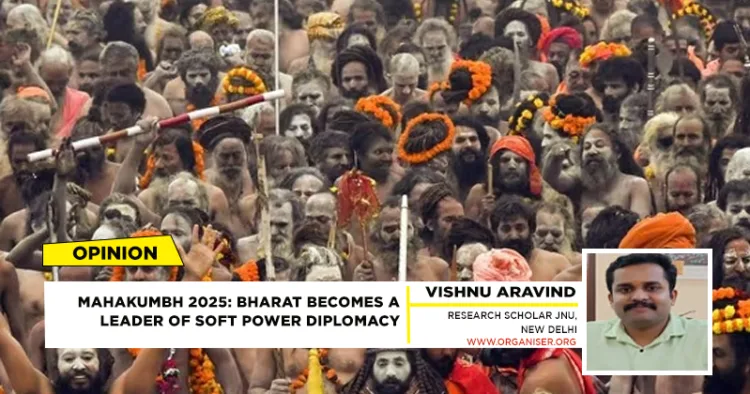The eye-catching buildings and Hollywood movies in the US, as well as the bridges and high-speed trains in China, are sights that constantly amaze the world. Such cultural icons are one factor that draws other countries and people closer to them. Similarly, Bharat is emerging as a miracle of cultural diplomacy. In world politics, where soft power diplomacy plays an important part in deciding countries’ worldwide influence, our nation is also impressing the world with the Mahakumbh, which has become a showcase for ideals such as unity, equality, spirituality, sustainability, inclusiveness, and tolerance.
In a world fraught with religious, racial, and national tensions, the Mahakumbh has evolved into a cultural event that unifies humanity and represents a symbol of security, stability, management and peace. While many global pilgrimage sites are designated for adherents of their religions, Bharat has opened the doors of the Kumbh Nagar to humanity, regardless of caste, religion, colour, or nationality. As a result, Prayagraj witnessed the world’s largest spiritual gathering, with over 45 crore people in attendance. In reality, Mahakumbh’s spiritual marvel has evolved into applying the ‘Vasudhaiva Kutumbaka’ philosophy. This has increased Bharat’slobal profile.
Today, the world can comprehend the true heart of Bharat because spirituality has been included in Bharat’ soft power diplomacy, which was previously restricted to film, dance, books, and music. As a result, Bharat and HiHindus’egitimacy and recognition in the global political and economic arenas have grown significantly. Bharat has gained worldwide popularity via Yoga, Ayurveda, Ramayana, and Buddha. Hindu philosophy was an unexpected gift from Bharat to the rest of the globe, who thought Western capitalism and globalisation were the end of human advancement. As a result, the world accepted Bharat’s yoga and the vision of ‘Vasudhaiva Kutumabakam’ ‘wholeheartedly.
Spirituality will significantly impact Bharat’s identity in future global politics. Bharat has skilfully used this unparalleled spiritual gathering to showcase its cultural and moral leadership to a divided globe. As a result, Bharat is growing as a cultural power while strengthening its global leadership position. The Kumbh Mela alone draws more people than the national populations of countries such as the United States, Russia, and Pakistan. Many millions of people indirectly join the spiritual environment created by the Kumbh Mela. These include people from many walks of life, rich and poor, and diverse social classes. Therefore, Mahakumbh provides an extraordinary opportunity for Bharat to bring this immense diversity on a single platform and showcase it to the world.
Bharat has also made the Mahakumbh a global unity and cultural exchange platform. As a result, not only devotees of Sanatana Dharma but also Bharatiyas and non-Bharatiyas who believe in Islam and Christians flock to Prayag Raj. This is why UNESCO declared the Kumbh Mela a cultural heritage site in 2017, recognising its global acceptance and significance. This is the first time the Kumbh Mela has been staged with global participation. Before the inauguration, the government invited more than 70 representatives of the countries to see the preparations. In January, a delegation of Indian descent visited Mahakumbh Nagar on the 15th Pravasi Bharatiya Divas. In addition, 190 representatives from all over the world were invited. An international delegation with representatives from Fiji, Finland, Guyana, Malaysia, Mauritius, Singapore, South Africa, Sri Lanka, Trinidad and Tobago and the United Arab Emirates (UAE) also visited Prayag Raj. The most important is that more than 15 lakh foreigners and tourists are expected to attend the Kumbh Mela. In addition, hundreds of foreign media, social media influencers and vloggers will take the Kumbh Mela to every nuke and corner of the world.
They present this union as a platform for unity and equality, bringing together people from different cultures and traditions. In addition, the world’s leading universities, including Havard and the London School of Economics, have sent their study team to Prayag Raj. Global visual media like CNN, Washington Post and BBC also capture every moment of the Mahakumbh. Undoubtedly, this will further enhance the global image and credibility of Bharat and Bharatiyas. In this way, Bharat’s traditional knowledge and heritage will be demonstrated, and its global participation will be enhanced; thus, the soft power diplomacy of Bharat will be more than ever expressed.
If the potential of this spiritual gathering is harnessed and linked to national interests, all Kumbh Melas can become a milestone in Bharat’s foreign policy. While anti-Hindu forces abroad portray Bharat as a land of riots and lack of religious freedom, the world is witnessing a confluence of the Ganges, Yamuna and Saraswati that will render them all ineffective: The Mahakumbh appeals to the world that Bharat is a land of unity, peace and tolerance. It has economic and political significance. For a nation-state’s economic and technological growth, trust and acceptance in the world are essential. This confidence manifests in the democracy this country upholds and the atmosphere of freedom, equality, tolerance and peace. Bharat’s message through the Kumbh Mela is a perfect example of all this. No investor will be afraid to invest in a country as generous as Bharat. This becomes even more understandable when compared with China and Russia’s social and political environment. That is why India continues to have the highest economic growth globally. This Maha Sangam provides a boost to this. As the largest gathering of mankind, Bharat thus plays a leading role in the world’s economic, political, and cultural diplomacy.



















Comments